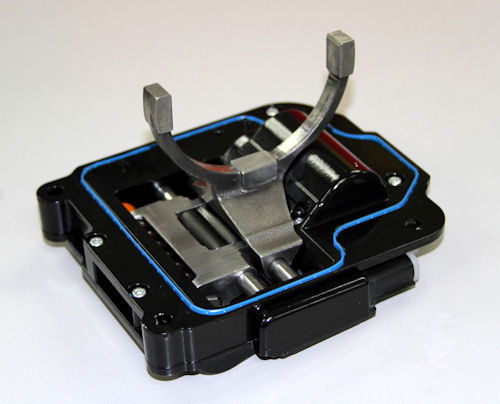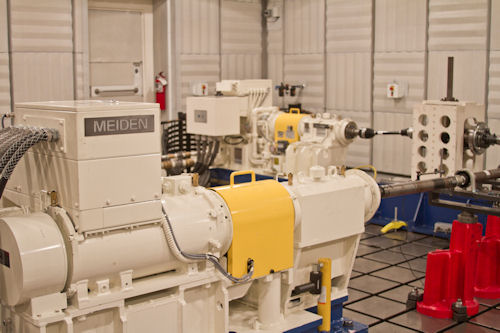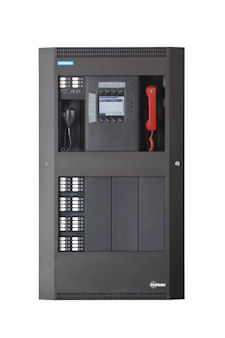Latest News
August 1, 2012
By Debbie Sniderman
Mechatronics, systems that contains both mechanical components and electronics with controlling software, have become increasingly common. The systems typically include components from multiple vendors, and often are used as the basis for a product family with many variations and configurations. The same system can be used in vastly different applications, some of which are mission-critical.
Integrating computers, controls, and electronics into products that perform mechanical functions makes testing more difficult, and changes the way it is approached. Here are two ways companies are integrating current testing technologies while developing new mechatronic products.
1. NVH and Performance Testing: AAM Drivelines
American Axle & Manufacturing (AAM), a global Tier 1 automotive supplier of driveline and drivetrain products, is developing a new torque transfer device and an electronic disconnect for an all-wheel drive (AWD) driveline. It provides the capability for full torque vectoring, front to rear and left to right, and is able to mechanically disconnect rotating components when not in use.
 |
| AAM’s disconnecting AWD system actuator. |
Thanks to a series of electronic actuators integrated into the mechanical device, this new mechatronic product allows AWD systems to have both high performance and high fuel economy, according to Dr. Glen Steyer, AAM’s executive director of Analytical System Engineering. The actuators themselves are also mechatronic systems, having onboard control circuits, an electric motor that drives a gear train, and a mechanism that moves shifter boards to allow for disconnection.
There are also intelligent sensors that confirm the shifter board’s position—considered safety critical parts. There’s physical motion in the gear train, mechanical motion of the actuator, and electronic signals from the onboard controller and smart sensors.
Physical Test Motivations
Steyer explains that simulation technologies are used to define a robust design, allowing them to enter into the prototype phase with a high degree of confidence in the performance. During the development phase, in addition to design optimization and experimental validation, physical testing is done to confirm that the design is correct, that the assembly is to spec, and that all parts work well together.
AAM also tests prior to launch to ensure the quality of components. Steyer notes that the industry drives the company toward high levels of reliability for mission-critical components such as drivetrains, where individual components have to reach fractions of incidents per thousand vehicles (IPTV).
“It takes confirmation with physical testing that we’re meeting the performance and reliability targets,” he says. “We need higher levels of assurance and confidence that we will pass testing at the end of the design phase, to proceed with the launch without impact or delay.”
Testing Technologies
A series of highly automated software tests are conducted on the controllers to confirm electrical functionality. Hundreds of thousands of test cycles and possible command states and operational state combinations are tested.
“We need positive confirmation that when asked to engage or disengage, it does,” Steyer says. “Testing involves sending computer command signals to cycle through the engage and disengagement, and monitoring whether the position is achieved through onboard smart sensors.”
In addition to functionality testing, AAM incorporates noise, vibration and harshness (NVH) testing to verify the durability of components mounted on the powertrain that will see road shock, adverse vibrations and thermal environments. Components are subject to shaker tests, where they are mounted to a shaker table and must continue functioning after a prescribed number of hours.
AAM’s actuators are also subjected to thermal chamber testing to ensure electrical and mechanical functionality is maintained before, during and after cycling through extreme temperatures.
Implementing NVH Testing
Steyer reports that AAM’s new product has the ability to sense and disconnect its rotating components when needed while driving. The onboard controller will anticipate when this functionality is needed, which depends on many factors, such as the driving state, speed and recent driving history. It can even gauge weather conditions to anticipate wet roads if the windshield wipers are on. When the system anticipates a need, it brings the rotating components from standstill up to speed within a fraction of a second to fully engage with the driveline. This action needs to be totally transparent to the user, however—there can be no noticeable shock or vibration.
Much effort is spent calibrating the system to engage it through tremendous acceleration as smoothly as possible. Testing is done on the vehicle with instruments measuring NVH and the “subjective feel” of the driver. An AWD NVH dynamometer is used to test the full system, including the power takeoff unit, prop shaft, torque transfer device and rear drive assembly, along with half shafts that go out to the wheel ends.
 |
| AAM has 17 dynamometers for product testing. Pictured here is the AWD NVH driveline system dynamometer. |
Transients of engagement and disengagement are tested, and measurements are taken of the driveline components, radiated noise, torsional acceleration, speed differentials and response times of the system, under a variety of operating conditions and hardware build variations.
“It is important for AAM to do testing outside of the vehicle, without an expensive prototype available. This way, we have lead time in the program to do calibration prior to having the integration vehicles available,” Steyer says. “This type of driveline testing on a dynamometer system allows for evaluation of the numerous powertrain combinations in a compressed product development schedule, with fewer prototype vehicles.”
AAM’s “dynos” acquire 40 channels each of high-frequency sampled data and slow-speed functional data, measuring nominal speeds, torques and temperatures. A couple gigabytes of data can be acquired each test day characterizing the system, requiring sophisticated algorithms to understand the performance. In addition, high-level accelerometers, microphones and other instruments such as telemetry systems measure detailed physical parameters. NVH algorithms process the data into psychoacoustic metrics that attempt to predict the driver’s subjective impressions about loudness, roughness, sharpness or other qualities.
The subjective aspect of NVH testing is important, Steyer says, because AAM’s designs, components and systems interact with humans who have different perceptions and expectations, and make judgments about acceptability and quality.
“As much as we have moved the science to objectively quantifying those metrics, there is still subjectivity involved,” he points out. “For those areas, we need physical testing, to make sure to satisfy the concerns of the customer.”
2. Testing Siemens Fire Alarm Systems
A second example of mechatronics testing can be found in how Siemens produces and tests fire alarm systems for large buildings. These mechatronic systems contain buzzers, alarms, smoke detectors and sprinklers controlled by a central machine. They open and close doors, control and diverge air flow, provide actions for egress, and emit voice messages to direct people to certain rooms. They have electrical sensors and actuators, mechanical interactions and intelligent software controls.
 |
| A Siemens fire panel. |
In the past, testing these systems was done manually. A board would be created containing the sensors, smoke would be emitted over them, and testers would look at the control panels to see whether the sensors responded and whether they were configured properly.
Because fire alarm systems are almost always custom-configured for each customer, testing can be complicated. There are different scale systems for a small deployment, such as a store with a fire control system and 12 sensors, or a large deployment, such as an entire building with many floors and doors. Also, customers may need one type of fire system to handle a single building and another to handle an entire university campus, for example.
With such a high level of complexity at the component, system and configuration levels, automated testing technologies are needed not only to run operational tests, but to determine which tests are needed and how they should be configured.
IMBT: A New Approach to Integrating Tests
Roberto Silva-Filho and Christof Budnik, engineers at Siemens Corporate Research and Technology in New Jersey, describe a new approach the company is using to test complicated mechatronic systems like fire alarms. Their paper, “An Integrated Model-Driven Approach for Mechatronic Systems Testing,” was presented at the Fifth IEEE International Conference on Software Testing, Verification and Validation (ICST) in Montreal.
Siemens Corporate Research and Technology uses test design studio (tedeso), a model-based testing (MBT) technology, to automatically create test scenarios of its customers’ fire alarm systems based on their specifications. When one of their customers, who are other Siemens companies, desire to modify or upgrade a fire alarm system or add new siren sounds, tedeso generates tests for the entire system with the modifications.
The new approach, integrated MBT (iMBT), combines MBT using tedeso with automated test generator and test execution engines. Adding a modeling description of the deployment configuration allows testers to generate both tests and different system configurations.
“There is now a unified view of all components of the system,” Budnik says, adding that test cases no longer need to be manually developed.
The main benefit of this type of testing is that it allows thorough system testing, which is hard to do manually on a large scale. Because software determines the configurations and runs the tests automatically, the system can be tested under a wider range of configurations—reducing the chance of faults.
Testing Implementation
Simulations are made of all the internal system components, so they can be directly interacted with and put into different states. Simulations are used to test configurations as early as possible. Instead of purchasing and setting up devices, extremes are tested under various operational conditions using simulations.
In addition to simulations, the testing environment can either consist entirely of “real parts” or be a mixture of simulated and actual sensors. “Smart hardware” can simulate multiple clients, and the software helps set up the test environment. When comparisons are desired, mixing physical testing with software can test pieces of a system that haven’t yet been developed, or were developed by multiple vendors.
Many different types of functional tests are run to see that all sensors respond. For example, operation of the fire panel controller is verified even if the power supply is cut off, or if sections are destroyed or disconnected. Operation is verified for simulated hardware failures or situations where many alerts arrive at once, and how the system scales during peak demand is observed.
Despite being combined with simulated parts, Budnik says, physical testing of real hardware components is still relevant. It is important to test the optical smoke detector, for example, to ensure it triggers correctly by spraying smoke in a room. Even though audio system testing can be automated with tone patterns, it is still crucial to listen to the actual output to make sure the right pattern is played and that it is understandable, he says.
Debbie Sniderman is an engineer, writer and consultant in manufacturing and R&D. Contact her at VIVLLC.com.
More Info
American Axle & Manufacturing Inc.
Siemens USA
Subscribe to our FREE magazine, FREE email newsletters or both!
Latest News
About the Author
DE’s editors contribute news and new product announcements to Digital Engineering.
Press releases may be sent to them via [email protected].





